|

On eBay Now...
1948 Jewish HEBREW MANUAL BOOK Israel BREN LIGHT MACHINE GUN Independence WAR For Sale
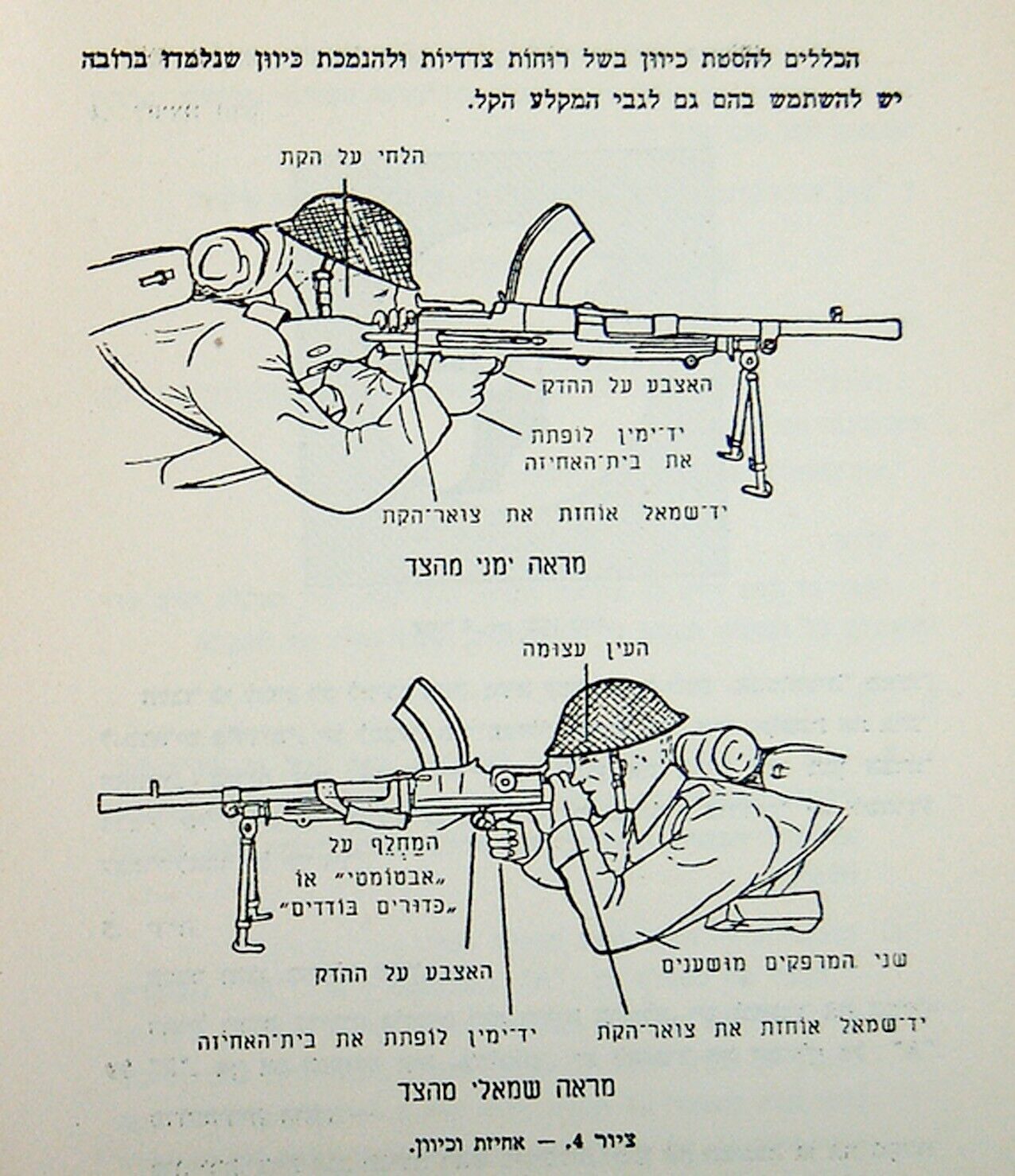
When you click on links to various merchants on this site and make a purchase, this can result in this site earning a commission. Affiliate programs and affiliations include, but are not limited to, the eBay Partner Network.

1948 Jewish HEBREW MANUAL BOOK Israel BREN LIGHT MACHINE GUN Independence WAR:
$185.00
DESCRIPTION : This UNIQUE , EXTREMELY RARE and ONE OF ITS KIND book , Being a BREN GUN MANUAL .The MANUAL guide book was originaly published in 1942 Eretz Israel - Palestine .An illustrated Jewish - Judaica - Hebrewbook ( Namely - manual ) , a guide book for the usage of the BREN LIGHT MACHINE GUN for theJewish-Israeli-Hebrewmembers of the \"PALMACH\" and \"HAGANAH\", TheJewish-Hebrew members of the pre IDF - ZAHAL military UNDERGROUND GROUPS during the British Mandateperiod in Eretz Israel ( Then also refered to as PALESTINE ) . The original Hebrew MANUAL - GUIDE book waspublished in Eretz Israel - Palestine in 1942 by the\"PALMACH\" and \"HAGANAH\" for the usage of the SOLDIERS - WARRIORS. They used the BREN LIGHT MACHINE GUN during the 1948 WAR OF INDEPENDENCE ( The 1948 Israel - Arab WAR ) and all the pre-war MILITARY ACTIONS.It\'s a HEBREW manual for the BREN GUN USAGE named \" THE LIGHT MACHINE GUN BREN\". First published illegaly by the pre IDF forces in 1942 .This UNIQUE later edition is dated 1948 and it was published by the newly established IDF ( Israel Defence Forces ) - Right after the establishment of the INDEPENDENT STATE of ISRAEL and its formal and official ARMY - Namely the IDF - ZAHAL. Illustrations of the BREN LIGHT MACHINE GUN and all its PARTS and armed IDF Jewish-Hebrew SOLDIERS. Thorough DETAILS regarding the BREN GUN , Handling it , Cleaning it, Dismantling and mantling it, Aiming, Firing and using it in BATTLE. .Thin cardboard wrappers. Hebrew. Throughout illustrated. Around 5 x 7 \" . 64 illustrated pp . Very good condition. Hardly used. Clean and unstained. Tightly bound. Very nicely preserved ULTRA RARE copy .( Pls look at scan foraccurate AS IS images ) Will be sent inside a protective rigidpackaging . AUTHENTICITY : Thisis anORIGINALvintage 1948 ( dated ) MANUAL - GUIDE book, IDF PUBLISHING , NOT a reproduction or a reprint , Itholds alife long GUARANTEE for itsAUTHENTICITY and ORIGINALITY.PAYMENTS : Payment method accepted : Paypal& All credit cards.
SHIPPMENT :SHIPP worldwide via registered airmail is $ 25 .Will be sent inside a protective packaging. Handling around 5 days after payment.
TheTheBren gunis a series oflight machine guns(LMG) made by Britain in the 1930s and used in various roles until 1992. While best known for its role as the British andCommonwealthforces\' primary infantry LMG inWorld War II, it was also used in theKorean Warand saw service throughout the latter half of the 20th century, including the 1982Falklands War. Although fitted with abipod, it could also be mounted on a tripod or be vehicle-mounted.The Bren gun was a licensed version of the Czechoslovak ZGB 33 light machine gun which, in turn, was a modified version of theZB vz. 26, whichBritish Armyofficials had tested during a firearms service competition in the 1930s. The later Bren gun featured a distinctive top-mounted curved box magazine, conical flash hider, and quick change barrel. The nameBrenwas derived fromBrno, the Czechoslovak city inMoravia, where the Zb vz. 26 was designed (in theZbrojovka Brno Factory) andEnfield, site of the BritishRoyal Small Arms Factory. The designer wasVáclav Holek, a gun inventor and design engineer.In the 1950s, many Bren guns were re-barrelled to accept the7.62×51mm NATOcartridge and modified to feed from the magazine for theL1(Commonwealth version of theFN FAL) rifle as the L4 light machine gun. It was replaced in the British Army as the section LMG by theL7general-purpose machine gun(GPMG), a heavierbelt-fedweapon. This was supplemented in the 1980s by theL86 Light Support Weaponfiring the5.56×45mm NATOround, leaving the Bren gun in use only as a pintle mount on some vehicles. The Bren gun was manufactured byIndian Ordnance Factoriesas the \"Gun Machine 7.62mm 1B\"[3]before it was discontinued in 2012.[4]Contents1 Development2 Service2.1 Second World War2.2 Post-war3 Variants3.1 Mark 13.2 Mark 23.3 Mark 33.4 Mark 43.5 L43.6 Taden gun3.7 Semiautomatic Bren guns4 World War II production5 Users6 Gallery7 See also8 Notes9 References10 External linksDevelopment[edit]At theBattle of Ortona, December 1943Australian assault on a pillbox at Giropa Point, January 1943A member ofNo. 9 Commandoat Anzio, equipped for a patrol with his Bren gun, 5 March 1944A Bren gunner of theNorwegian Brigadetakes aim during training at Dumfries, Scotland, 27 June 1941.At the close of theFirst World Warin 1918, the British Army was equipped with two main automatic weapons; theVickers medium machine gun(MMG) and theLewis light machine gun(LMG). The Vickers was heavy and required a supply of water to keep it in operation, which tended to relegate it to static defence and indirect fire support. The Lewis, although lighter, was still heavy and was prone to frequent stoppages; its barrel could not be changed in the field, which meant that sustained firing resulted in overheating until it stopped altogether. In 1922, to find a replacement for the Lewis, the Small Arms Committee of the British Army ran competitive trials between theMadsen, theBrowning Automatic Rifle(BAR), theHotchkiss, theBeardmore-Farquhar, and the Lewis itself. Although the BAR was recommended, the sheer number of Lewis guns available and the difficult financial conditions meant that nothing was done. Various new models of light machine gun were tested as they became available, and in 1930, a further set of extensive trials commenced, overseen byFrederick Hubert Vinden.[5]This time the weapons tested included theSIG Neuhausen KE7, theVickers-Berthierand the Czechoslovak ZB vz.26. The Vickers-Berthier was later adopted by theIndian Armybecause it could be manufactured at once, rather than wait for the British Lewis production run to finish; it too saw extensive service in World War II.[6]Following these trials, the British Army adopted the Czechoslovak ZB vz.26 light machine gun manufactured inBrnoin 1935, although a slightly modified model, the ZB vz. 27, rather than the ZB vz. 26 which had been submitted for the trials. The design was modified to British requirements under new designation ZGB 33, which was then licensed for British manufacture under the Bren name. The major changes were in the magazine and barrel and the lower pistol grip assembly which went from a swivelling grip frame pivoted on the front of the trigger guard to a sliding grip frame which included the forward tripod mount and sliding ejection port cover. The magazine was curved in order to feed the rimmed.303 SAA(\"Small Arms Ammunition\") cartridge, a change from the as the8mm Mauserround previously used by Czech designs. These modifications were categorised in various numbered designations, ZB vz. 27, ZB vz. 30, ZB vz. 32, and finally the ZGB 33, which was licensed for manufacture under the Bren name.The Bren was a gas-operated weapon, which used the same .303 ammunition as the standard Britishbolt-action rifle, theLee–Enfield, firing at a rate of between 480 and 540 rounds per minute (rpm), depending on the model. Propellant gases vented from a port towards the muzzle end of the barrel through a regulator (visible in the photo, just in front of the bipod) with four quick-adjustment apertures of different sizes, intended to tailor the gas volume to different ambient temperatures (smallest flow at high temperature, e.g. summer desert, largest at low temperature, e.g. winter Arctic). The vented gas drove a piston which in turn actuated the breech block. Each gun came with a spare barrel that could be quickly changed when the barrel became hot during sustained fire, though later guns featured achrome-lined barrel, which reduced the need for a spare. To change barrels, the release catch in front of the magazine was rotated to unlock the barrel. The carrying handle above the barrel was used to grip and remove the hot barrel without burning the hands.The Bren was magazine-fed, which slowed its rate of fire and required more frequent reloading than British belt-fed machine guns such as the larger .303 Vickers machine gun. The slower rate of fire prevented more rapid overheating of the Bren\'s air-cooled barrel, and the Bren was much lighter than belt-fed machine guns, which typically had cooling jackets, often liquid filled. The magazines also prevented the ammunition from getting dirty, which was more of a problem with the Vickers with its 250-round canvas belts. Thesightswere offset to the left, to avoid the magazine on the top of the weapon. The position of the sights meant that the Bren could be fired only from the right shoulder.[7]Service[edit]Second World War[edit]Indiantroops man a Bren gun on an anti-aircraft tripod,Western DesertApril 1941In the British and Commonwealth armies, the Bren was generally issued on a scale of one per rifle section.[8]An infantry battalion also had a \"carrier\" platoon, equipped withUniversal Carriers, each of which carried a Bren gun.[9]Parachute battalions from 1944 had an extra Bren in the AT platoon.[10]The 66-man \"Assault Troop\" ofBritish Commandoshad a nominal establishment of four Bren guns. Realising the need for additional section-level firepower, the British Army endeavoured to issue the Bren in great numbers, with a stated goal of one Bren to every four private soldiers.[11]The Bren was operated by a two-man crew, sometimes commanded by aLance Corporalas an infantry section\'s \"gun group\", the remainder of the section forming the \"rifle group\". The gunner or \"Number 1\" carried and fired the Bren, and a loader or \"Number 2\" carried extra magazines, a spare barrel and a tool kit.[12]Number 2 helped reload the gun and replace the barrel when it overheated, and spotted targets for Number 1.Generally, the Bren was fired from the prone position using the attached bipod.[13]On occasion, a Bren gunner would use his weapon on the move supported by a sling, much like an automatic rifle, and from standing or kneeling positions. Using the sling, Australian soldiers regularly fired the Bren from the hip, for instance in themarching firetactic, a form ofsuppressive firemoving forward in assault. AVictoria Crosswas awarded to PrivateBruce Kingsburyfor such use at Isurava, New Guinea, in 1942, during the Australians\' fighting retreat from Kokoda.Bren gunner of theRoyal ScotsinNorth Brabant, the Netherlands, 1944Each British soldier\'s equipment normally included two magazines for his section\'s Bren gun. The large ammunition pouches on the1937 Pattern Web Equipmentwere designed around the Bren magazine. Every soldier would be trained to fire the Bren in case of an emergency, though these soldiers did not receive a Bren proficiency badge.[citation needed]The Bren had an effective range of around 600 yards (550m) when fired from a prone position with abipod.[11]For a light machine gun of the interwar and early World War II era, the Bren was about average in weight. On long marches in non-operational areas it was often partially disassembled and its parts were carried by two soldiers. The top-mounted magazine vibrated and moved during fire, making the weapon more visible in combat, and many Bren gunners used paint or improvised canvas covers to disguise the prominent magazine.[14]The 30-round magazine was in practice usually filled with 27 or 28 rounds to prevent jams and avoid wearing out the magazine spring. Care needed to be taken when loading the magazine to ensure that each round went ahead of the previous round, so that the .303 cartridge rims did not overlap the wrong way, which would cause a jam. The spentcartridge caseswereejected downwards, which was an improvement on the Lewis gun, which ejected sideways, since the glint of them flying through the air could compromise a concealed firing position.[15]Bren carried by a Canadian soldier in 1945In general, the Bren was considered a reliable and effective light machine gun, though in North Africa it was reported to jam regularly unless kept very clean and free of sand or dirt.[11]It was popular with British troops, who respected its reliability and combat effectiveness. The quality of the materials used would generally ensure minimal jamming. When the gun did jam through fouling caused by prolonged firing, the operator could adjust the four-position gas regulator to feed more gas to the piston increasing the power to operate the mechanism. The barrel needed to be unlocked and slid forward slightly to allow the regulator to be turned. It was even said that all problems with the Bren could simply be cleared by hitting the gun, turning the regulator or doing both. It was \"by general consent the finest light machine gun in the world of its period, and the most useful weapon provided to the (French) \"maquis\" ... accurate up to 1,000 meters, and (it) could withstand immense maltreatment and unskilled use. \"Resistants\" were constantly pleading for maximum drops of Brens\".[16]Bren with 100 round detachablepan magazine. With the magazine fitted, the original sights cannot be used.[17]Although they were generally well-liked, the high cost of £40 each gun was an issue for the British Army leadership. This became a greater issue when it was discovered that only 2,300 of the 30,000 Bren guns issued to the British Expeditionary Force came back to Britain after the defeat of France. As the result, cost savings and increased rate of production became two main goals for subsequent variant designs. The Bren Mk II design simplified production by replacing the drum rear sight with a ladder design, making the bipod legs non-adjustable, simplifying the gun butt, reducing the use of stainless steel, among other steps that reduced the cost by 20% to 25%; Mk II was approved in September 1940 and entered production in 1941. While the Bren Mk III design also aimed at reducing cost, it also had the concurrent goal of being lightened for jungle warfare; the final product weighed 19 pounds and 5 ounces (3 pounds lighter than the original Bren Mk I design); it was standardised in July 1944 and saw a production of 57,600. Also standardised in July 1944 was the Bren Mk IV, which was further lightened to 19 pounds and 2 ounces; however, it did not enter production until July 1945, and only 250 were built before the end of the war. While Enfield was able to produce only 400 Bren Mk I guns each month, with the various simplification efforts production numbers rose to 1,000 guns per week by 1943. Among the variant designs were two speciality prototypes that never entered production: The belt-fed Taden gun for stationary defence use, and the ultra-simplifiedBesalgun to be produced in case a German invasion of Britain actually took place (which would hinder British production efforts). Later designs of production Bren guns featured chrome-lined barrels that offered less resistance, preventing overheating and reducing the need for quick changes of barrels.[18]Bren guns were produced outside of Britain as well. In Canada, the John Inglis plant in Toronto began tooling its facilities for production in 1938; the first of 186,000 examples was completed in Mar 1940. Some of the Inglis-built Bren guns were chambered for the 7.92-millimeter Mauser ammunition; these were destined for export to Nationalist Chinese forces rather than for British and Commonwealth forces. In Australia, the Lithgow Small Arms Factory in New South Wales began building Bren guns in 1940; a total of 17,249 were built. In India, the factory at Ishapore began building Bren guns in 1942 (it had produced Vickers-Berthier machine guns prior to this time), and would continue producing them for decades long after the end of WW2. Many of the Bren guns produced at Ishapore went to Indian troops, who had lost a great number of automatic weapons during the disastrous campaigns against the Japanese in Malaya and Burma; 17th Indian Infantry Division, for example, found itself with only 56 Bren guns after fleeing out of Burma in 1942.[18]A complicated tripod mount was available to allow the Bren to be used as an indirect-fire weapon, but this was rarely used in the field. The Bren was also used on many vehicles, including onUniversal Carriers, to which it gave the alternative name \"Bren Gun Carrier\", and on tanks and armoured cars. It could not be used as a co-axial weapon on tanks, as the magazine restricted its depression and was awkward to handle in confined spaces, and it was therefore used on apintle mountonly. (The belt fedVickersorBesa, the latter being another Czechoslovak machine gun design adopted by the British, were instead used as co-axial weapons.) An unfortunate problem occurred when the Bren was fired from theDingo Scout Car; the hot cartridge cases tended to be ejected down the neck of the driver, whose position was next to the pintle. A canvas bag was designed to catch the cartridges and overcome the problem, but it seems to have been rarely issued.[15]Bren gun mounted on a tripod, 2010The Bren was also employed in theanti-aircraftrole. The tripod could be adjusted to allow high angle fire. There were also several designs of less-portable mountings, including theGallowsandMottleymounts. A 100-roundpan magazinewas available for the Bren for use in the anti-aircraft role.[19]The Bren\'s direct ancestor, the Czechoslovak ZB vz. 26, was also used in World WarII by German and Romanian forces, including units of theWaffen SS. Many7.92 mmZB light machine guns were shipped to China, where they were employed first against the Japanese in World War II, and later against UN forces in Korea, including British and Commonwealth units. Some ex-Chinese Czech ZB weapons were also in use in the early stages of theVietnam War. Production of a 7.92mm round model for the Far East was carried out by Inglis of Canada. The Bren was also delivered to theSoviet Unionas part of British Army, and the armies of various countries of theCommonwealth, used the Bren in theKorean War, theMalayan Emergency, theMau Mau Uprisingand theIndonesia–Malaysia confrontation, where it was preferred to its replacement, the belt-fedGPMG, on account of its lighter weight. In theconflict in Northern Ireland(1969–1998), a British Army squad typically carried the L4A4 version of the Bren as the squad automatic weapon in the 1970s.[21]During theFalklands Warin 1982,40 CommandoRoyal Marinescarried one LMG and one GPMG per section. Its final operational deployment with the British Army, on a limited scale, was to theFirst Gulf Warin 1991.[22]When the British Army adopted the7.62 mmNATOcartridge, the Bren was re-designed to 7.62mm calibre, fitted with a new bolt, barrel and magazine. It was redesignated as the L4 light machine gun (in various sub-versions) and remained in British Army service into the 1990s. A slotted flash hider similar to that of the contemporary L1 rifle andL7 general purpose machine gunreplaced the conical flash hider. The change from a rimmed to rimless cartridge and nearly straight magazine improved feeding considerably, and allowed use of 20-round magazines from the 7.62mmL1A1 Self-Loading Rifle. The 30-round magazine from the L4 also fitted the L1A1 rifle, but the magazine spring was not always strong enough to provide enough upward pressure to feed rounds correctly, this being remedied by stretching the magazine springs.Completion of the move to a5.56 mmNATO cartridge led to Army removing the Bren/L4 from the list of approved weapons and then withdrawing it from service.The Mark III Bren remained in limited use with theArmy Reserveof the Irish Defence Forces until 2006, when the 7.62mm GPMG replaced it. The Bren was popular with the soldiers who fired it (known as Brenners) as it was light and durable, and had a reputation for accuracy. The most notable use of the Bren by Irish forces was in theCongo Crisisduring the 1960s, when the Bren was the regular army\'s standard section automatic weapon.Bren guns were in service with theRhodesian Security Forcesduring theRhodesian Bush War, including a substantial number re-chambered for 7.62mm cartridges similar to those examples in the British Army.[23]The Rhodesian Bren guns continued to see frequent action until the 1970s, when they were largely replaced by theFN MAG.[24]A few were captured and re-issued by theZimbabwe People\'s Revolutionary Army(ZIPRA).[25]Some examples were still in service with reservists of theBritish South Africa Policein 1980, and were inherited by theZimbabwe Republic Policeupon the country\'s internationally recognised independence.[26]Zimbabwean policemen continued to deploy Bren guns during operations against ZIPRA dissidents throughout the early 1980s.[26]TheSouth African Defence Forcedeployed Bren guns during theSouth African Border Waralongside the more contemporary FN MAG as late as 1978.[27]Variants[edit]L4Mark 1[edit]Introduced September 1937; the original Bren, based on the Czechoslovak gun. Overall length 45.5 inches, 25 inch barrel length. Weight 22lb, 2oz.Features:Drum-pattern rear aperture sightButtstrap for use over-the-shoulder when firingRear grip under buttTelescoping bipodFolding cocking handleAn Enfield-made .303 Bren Mk 1 was converted to7.92mm BESAin 1938 due to the suggestion of a possibility of a British Army change over to a rimless cartridge for machine guns being mooted.[i]Mark 2[edit]Introduced 1941. A simplified version of the Mk1 more suited to wartime production with original design features subsequently found to be unnecessary deleted.[ii]Produced by Inglis of Canada and the Monotype Group through a number of component manufacturing factories. Sometimes known as the \"Garage hands\" model. Overall length 45.5 inches, 25 inch barrel length. Weight 23 lb, 3 oz.Features:Folding-leaf rear sightButtstrap deletedRear grip deletedFixed height bipodFixed cocking handleThe Bren Mk2 was much simplified in the body, which although still being milled from a solid billet of steel, required significantly fewer milling operations than the Mk1, resulting in a much cleaner appearance. The bipod was simplified in design as well as not having extending legs. Most Mk2 bipods resembled a simple A-frame and were more \'soldier proof\'. The Mk2 also featured a slightly higher rate of fire than the Mk1.The woodwork on the Mk2 was simplified by being less ornate and ergonomic, which sped up the manufacturing process. The barrel was also simplified by means of a non-stepped removable flash hider and, in some cases, a barrel fore-end that was matte instead of highly polished. The buffered buttplate of the Mk1 was omitted and replaced with a sheet metal buttplate.A small number of Inglis-made .303 Bren Mk 2 were converted post-war to fire the.2807 mm Mk 1Z round used by theEM-2 rifle.The Inglis version of the Bren Mk 2 chambered for the30-06cartridge and known as the M41 was also manufactured inFormosain 1952.Mark 3[edit]A shorter and lighter Bren made by Enfield from 1944 for the war in the East and for Airborne Forces. This was similar to the Mk2 but with the light weight features of the early Mk1. With the main distinguishing feature being a shorter barrel and serrated area in front of the barrel nut. Overall length 42.9 inches, 22.25 inch barrel length. Weight 19 lb, 5 oz.Mark 4[edit]As with the Mk3 but this was a conversion of a Mk2. Overall length 42.9 inches, 22.25 inch barrel length. Weight 19 lb, 2 oz.L4[edit]L4 or Machine Gun 1B in Indian serviceA conversion of the Bren to 7.62mm NATO from 1958. Indian Army variants may be new-build, not conversions. L4 Brens can easily be identified by their different magazine. The British-issue L4 magazine is of 30-round capacity and has a slight curve. The L4 magazine was interchangeable with theL1A1 SLRmagazine, so the L4 Bren also can be seen fitted with straight 20-round magazines from the SLR or with the straight 30-round magazine from the AustralianL2A1or Canadian C2A1 heavy-barrel SLR. The flash suppressor was changed from the cone type of .303 variants to a slotted type similar in appearance to that used on the SLR and L7 GPMG. All L4s are chambered for7.62×51mm NATOrimless ammunition.Assam Police constable manning Indian version of Bren LMGDesignation DescriptionL4A1 Bren Mk3 conversion originally known as X10E1, with Mk1 bipod and two steel barrels.[iii]L4A2 Bren Mk3 conversion originally known as X10E2, lightened bipod and two steel barrels.L4A3 Bren Mk2 conversion, one chromium-plated steel barrel.[iv]L4A4 L4A2 variant with one chromium-plated steel barrelL4A5 L4A3 with two steel barrels forRoyal NavyL4A6 L4A1 variant with one chromium-plated steel barrelL4A7 Conversion of MK1 Bren. None made but drawings prepared for overseas buyerL4A9 Bren conversion with L7 dovetailTaden gun[edit]Main article:Taden gunTheTaden gunwas a development of the Bren to use with the.280 Britishintermediate round proposed to replace the .303 in British service. The Taden was belt-fed with spade grips and would have replaced both the Bren and the Vickers machine gun. Although reliable[citation needed]it was not accepted due to the US-driven standardization within NATO on the larger7.62×51mm NATOround.[28]Semiautomatic Bren guns[edit]Many nations\' militaries have disposed of their Bren guns as surplus to their needs. Surplus Brens have been imported to the United States for sale to collectors, but due to US gun laws restricting the importation of automatic weapons such guns must be legally destroyed by cutting up the receivers. A number of US gunsmiths have manufactured new semiautomatic Brens by welding the pieces of destroyed receivers back together, with modifications to prevent the use of full automatic parts, and fitting new fire-control components capable of only semiautomatic fire. The balance of the parts are surplus Bren parts. Such \"semiautomatic machine guns\" are legally considered rifles under US Federal law and the laws of most states.World War II production[edit]\"Ronnie, the Bren Gun Girl\", poses with the finished product at the John Inglis plant, Toronto, 1941RSAF Enfield, UK: 400 per month.1943: 1,000 per week.John Inglis and Company, Canada: A contract was signed with the British and Canadian governments in March 1938 to supply 5,000 Bren machine guns to Great Britain and 7,000 Bren machine guns to Canada. Both countries shared thecapitalcosts of bringing in this new production facility. Production started in 1940, and by 1943 Inglis was producing 60% of the world output of Bren machine guns.Long Branch, Toronto, Canada.Kanpur, India: The first Indian-made Bren was made in .303 British in 1953 before it was later rechambered to fire 7.62 NATO ammo in 1964.[29][30]Lithgow Small Arms Factory, Australia.Users[edit]Watched by two small boys, a member of the FFI (French Forces of the Interior), poses with his Bren atChâteaudun, 1944.Algeria:National Liberation Armyreceived 500 Brens from Egypt[31]Australia: during World War II and Korean War.Indonesia–Malaysia confrontation(as L4A4).[32]Continued in limited service until about the time of the general introduction of theF88 Steyr(ca 1990).[citation of Bulgaria: received Czech-made Brens in8×56mmR, designatedkartěnice African Republic: used byGendarmerieandRepublican Guard[39]Croatia: Mark 2 version known to be used in theCroatian War of Independence.[40]People\'s Republic of China: Many guns captured fromKuomintang. Used duringKorean War.[41]Some converted to fire 7.62x39 caliber ammunition from ammo supplied by their Soviet allies. They used regular AK-47 magazines.[42]Republic of China (1912–1949): used byNational Revolutionary Army[43]43,000 guns produced in7.92×57mm MauserbyInglisin Canada.[44]Taiwan: Produced a.30-06 Springfieldversion of Bren Mk II, theType 41(1952).[45][42]Democratic Republic of Congo[33]Central African Republic[46]Cyprus[47][48]Denmark: post-war[49]Egypt[50]FranceFree France: Used by theFree French ForcesandFrench Resistance.[51][52]Vichy France: Captured Brens were issued to theMilice.[53]French Far East Expeditionary manufactured by theOrdnance Factories Board[3][33]Phased out of Indian military service in 2012.[4]Indonesia[58][59]Ireland:Irish Defence Forces, replaced by theFN MAGin 1960s.[60]Remained in use with Irish military reserve forces until the early 2000s.Israel: During itswar of independenceand for some time thereafter by the Haganah and the Israeli Defense Forces. Replaced afterOperation also issued to theItalian Co-Belligerent Armyin the latter part of WWII. It continued to see post-war use with the Italian Army.[62]Also used by theItalian Policein .30-06 caliber.[42]Jamaica[4]Japan: captured weapons.[63]Jordan:Arab Legion[64]Kenya[33]North Germany: used captured examples[68]under the designation7.7 mm Leichtes MG 138(e)[60]Nepal:[33]Bren L4[69]Netherlands: post-war[70]New Zealand: WWII and L4 post war[71]Nigeria[72]Norway: post-war[73]Pakistan[4]Papua New Guinea[74]Poland: Used by thePolish Underground State[citation needed]andPolish Armed Forces in the West[75]during World War Leone[78]South Africa[27]Sri Lanka: Used byCeylon Defence Forcein World War II[79]and thereafter by theSri Lanka Armyuntil the late 1970s.[citation 294 guns were purchased by theTibetan Armyin 1950.[81]Tonga[33][82]Trinidad and Tobago[33]Uganda[33]United Kingdom: British and Commonwealth forces, and cadet forces until the introduction of theL98 Cadet RifleState of Vietnam[54]Vietnam: used byViet-Minh[83]South Yemen[84]Soviet Union: Supplied by the United Kingdom during the Lend-Lease program.[85]Yugoslavia:Yugoslav PartisansandChetniksduring World War II[86][87]; some remained in stockpiles until theYugoslav Wars[citation needed]Zimbabwe:[33]******BRENLight Machine Gun (LMG) / General Purpose Machine Gun (GPMG)Based upon an excellent Czechoslovakian design, the equally-excellent BREN Light Machine Gun was adopted into service with the British Army in the late 1930s.Authored By: Dan Alex | Last Edited: 5/23/20191/11Credit: Image copyright www.MilitaryFactory.com; No Reproduction Permitted.2/11Credit: Image copyright www.MilitaryFactory.com; No Reproduction Permitted.3/11Credit: Image copyright www.MilitaryFactory.com; No Reproduction Permitted.4/11Credit: Image copyright www.MilitaryFactory.com; No Reproduction Permitted.5/11Credit: Image copyright www.MilitaryFactory.com; No Reproduction Permitted.6/11Credit: Image copyright www.MilitaryFactory.com; No Reproduction Permitted.7/11Credit: Image copyright www.MilitaryFactory.com; No Reproduction Permitted.8/11Credit: Image copyright www.MilitaryFactory.com; No Reproduction Permitted.9/11Credit: Image copyright www.MilitaryFactory.com; No Reproduction Permitted.10/11Credit:11/11Credit:The BREN Light Machine Gun was the standard light machine gun of the British Army and Commonwealth forces throughout World War 2 and beyond. The type\'s existence was actually owed to the 1920\'s-era Czech ZB vz/26 Light Machine Gun brought to the British Army\'s attention prior to adoption of other types during a long-lasting, years-long search. The simple-yey-excellent ZB vz/26 was adopted by the Czech Army in 1924 with production out of the storied Brno facility. Chambered for the 7.9mm rimless cartridge, it operated from a top-fed, straight detachable box magazine through a gas-operated action featuring a tilting breechblock. The weapon was heavily adopted elsewhere (including Nazi Germany as the MG 26(t)) and saw extensive service in the Chinese Civil War (1927-1937, 1946-1950), World War 2 (1939-1945), the Malayan Emergency (1948-1960), the Korean War (1950-1953), the Suez Crisis (1956), the Congo Crisis (1960-1965), the Rhodesian Bush War (1964-1979), The Northern Ireland \"Troubles\" (1966-1998) and the Falklands War (1982).Prior to World War 2, the British Army sought to find a viable and improved replacement for their existing Lewis Light Machine Gun line which proved a limited light machine gun design at best. A visit to Czechoslovakia alerted authorities to a locally-designed, well-rounded system in the ZB vz/26. With examples delivered to Britain for further testing in 1930, several other competing designs were entertained well into 1934. The ZB vz/26 evolved into the vz/27 and this begat the vz/30, vz/32 and vz/33 marks in time. All preceding marks up to the vz/30 were modified to fire the original 7.92mm Mauser cartridge which was of little value to the British need. It was the vz/30 that adopted the .303 British cartridge as the \"ZGB vz/30\" prototype of 1930 and underwent trials from 1931 to 1932. The following ZGB vz/33 development of 1933 became the official basis for the finalized British design. It was soon settled to adopt the Czech system for the Army with the British-centric changes to suit requirements. Design work continued into 1935, affording the design the official designation of \"BREN\" which paid homage to the weapon\'s true origin (BR = \"Brno\") and its place of main manufacture (EN = \"Enfield Lock\" through the Royal Small Arms Factory).The primary (and most major) change to the Czech design was in the chambering - the Czech version utilized the German 7.92mm Mauser rimless rifle cartridge. For the sake of logistics and familiarity, the British instead opted for their .303 British rimmed rifle cartridge which was already in widespread circulation. This then forced changes to the Czech design\'s internals and a new curved magazine was developed to house the rimmed cartridges (giving the BREN its very defined and highly recognizable profile). The end result was largely faithful to the original Czech offering with its gas-operated, tilting bolt repeat-fire action retained. The overall design was highly linear in its general form with the rectangular receiver capped at one end by a solid shoulder buttstock and at the other end by the usual barrel and gas cylinder arrangement. The gas cylinder was fitted under the barrel in a traditional way and tapped expelled high pressure gas from exiting rounds for use in each subsequent round by converting the gas into required pressure to work the internal action. The weapon featured a standalone pistol grip with integrated trigger group slung under the rear portion of the receiver. A carrying handle was affixed to the barrel roughly at the midway point of the design. The barrel was capped by a conical flash hider and a folding bipod was fitted at the tip of the gas cylinder. The charging handle was set to the right side of the receiver and the new curved magazines were inserted through a top-mounted gate. Spent shell casings were ejected cleanly through the bottom of the receiver.Production was assigned to the fabled Royal Small Arms Factory at Enfield Lock and set to begin in 1937. First deliveries began to reach frontline units in 1938. As British and Commonwealth involvement ramped up, so too did production of the BREN and eventually involved Canadian (Inglis and Long Branch), Australian (Lithgow) and Indian (Ishapore) factories. With the Chinese caught in its own bitter war against the Empire of Japan in Asia, BREN guns were also competed in their original 7.92mm Mauser chambering and sent overseas in support of Nationalist Chinese forces.In practice, the BREN gun met nearly all expectations as a reliable, combat-friendly portable weapons system. Its sheer simplicity in design allowed for quick repair and maintenance in-the-field where gunners could quickly assemble and field-strip the weapon in minutes. The action also proved highly sound so as to produce a minimum number of stoppages. The type\'s overall weight - approximately 22.5lbs - made the BREN very portable in long marches and when relocating the gun to more advantageous positions. It featured a sound effective target range of 600 yards and a maximum area range out to 1,850 yards with a firing rate of 500 to 520 rounds per minute - the seemingly low rate-of-fire accounting for more effective cooling of the barrel between bursts, and thusly lowering the chance of a fractured barrel being encountered. An overheated barrel could also very quickly be addressed by the two-man crew in minutes. The .303 British cartridge gave good penetration value at range with its 2,400 feet per second muzzle velocity. Sighting was through iron arrangements standardized on the design from the beginning. If the BREN held any limitations, it was in its 30-round magazine which allowed for limited bursts of firing before reloading was required. However, as a light machine gun, use of magazines made for a highly portable weapon not requiring belted ammunition which could misfeed without proper attention. An operator not use to the downward ejection of casings could also be caught by surprise. Nevertheless, BREN machine gunners enjoyed their weapon and considered it a very accurate ranged system. A typical issue in British ranks was one gun per section with a crew of two assigned to each weapon - ammunition dispersed across the section.BREN use was not only limited to its defined light machine gun, squad-level role. Several mounting types soon appeared which broadened the tactical role of the weapon considerably. Specialized tall tripod mountings allowed for the weapon to be used as a low-level anti-aircraft defensive system (complete with an empty casings soft bag) to help defend airfields and the like. The BREN was also a standard fixture across many British and Commonwealth military vehicles of the war when fitted on trainable mounts, able to engage cleanly around the vehicle and over it. A heavy duty tripod (weighing some 26.5lbs) was developed with applicable sighting optics and this made the BREN an effective defensive system when used in a fixed position while protecting vital areas and camps.The BREN LMG appeared in several notable marks throughout its storied career. Initial versions were the \"Gun, Machine, Bren, .303in Mark 1\" introduced in 1938. These closely followed the lines of the original prototypes and were fielded with a rather complicated drum-pattern rear sighting device. The butt sported a hinged grip handle that could be folded down for use by the support hand. A sling system was also fitted which allowed the operator to carry the weapon across the shoulder and effectively wield the machine gun with both hands when \"firing from the hip\". A telescoping bipod was added under the gas cylinder and the cocking handle was of a foldable design intended to reduce snagging. However, in practice, the butt grip handle proved less than efficient and was dropped from further production in time. By 1940, there existed over 30,000 BREN examples in circulation, embedding itself as the standard British Army light machine gun. A hefty number of examples were lost in the miracle that was Dunkirk between May 26th, 1940 into June 4th, 1940. The resulting captured examples were then reconstituted by the advancing Germans and placed back into service as the \"Leichte MG 138(e)\".With Britain fully committed to war, the \"Gun, Machine, Bren, .303in Mark 2\" was introduced in June of 1941. An adjustable leaf-type rear sighting device was brought about to help simplify production and general operation - particularly in light of the equipment losses experienced at Dunkirk. The bipod was further simplified to a fixed design type as was the folding cocking handle. Surfaces were also simplified (lacking lightening grooves) for the sake of speedier production and lower procurement costs - though at the expense of a slightly heavier end-product.As the war raged on, the BREN system adapted to changes along the varied fronts. This produced the \"Gun, Machine, Bren, 303in Mark 3\" in July of 1944. This mark was generally similar to the Mark 1 of 1938 but given a shortened barrel assembly and cleaner production lines to simplify manufacture. The \"Gun, Machine, Bren, 303in Mark 4\" was nothing more than a late-war conversion of BREN Mark 2 guns to the BREN Mark 3 standard complete with modified buttstocks.In 1948, there proved a new Cold War-era offering of the BREN in the \"Gun, Machine, Bren, 303in, Mark 2/1\". This mark was broadly similar to the wartime Mark 2 though with a new slide assembly and cocking handle.In the post-war years, and based on the NATO adoption of the 7.62mm cartridge as a standard rifle/machine-gun caliber round, there began the modernized\"L4 LMG\"series that began with the \"L4A1\". L4A1 models were based on wartime BREN Mark 3 production models with changes instituted as required of the new 7.62mm cartridge. This included new straight magazines, barrel assemblies, a slotted flash suppressor, new breechblock and extractor and various other more subtle changes to the original design. The L4A1 was then improved in the upcoming L4A2 mark.Wartime BREN Mark 2 models were then upgraded through a similar process in the L4A3 modification. Barrels were now lined with chromium to help extend the service lives of the guns for a time longer. BREN Mark 3s were then upgraded with chromium-lined barrels to produce the L4A4 designation. The L4A5 models did not feature chrome-lined barrels but two barrels were issued to be changed as the situation called. The L4A6 mark sported a chromium-lined barrel and were upgraded L4A1 production models. The L4A7 was intended for use by the Indian Army but this endeavor fell to naught.All told, the BREN gave a good account of itself in the most dire of circumstances and conditions. It fought through mud and blood, desert and jungle in attempting to preserve the world from the tyranny brought about by the Axis powers and Cold War foes. This machine gun truly began a symbol of national pride and endured decades of formal use through seemingly countless conflicts. It no doubt deserves its standing amongst the best automatic small arms ever developed - and one of the best machine guns of all of World War 2 proper.Its use spanned beyond standard-issue forces of the conflict as well, being air-dropped to partisans in Italy, featured by Free French forces and appearing across various former colonies. Israelis operated the type during their War of Independence and Irish Defence Forces adopted the type to replace their FN MAGs in the 1960s. The Netherlands adopted the BREN in the post-war years for lack of anything better appearing at the time. The BREN proved popular in many African nations in the post-war years.The BREN gun was produced by the Royal Small Arms Factory of Enfield Lock in Britain, John Inglis and Company of Canada, the Long Branch Company of Canada, Ishapore of India and the Lithgow Small Arms Factory of Australia.The last of the BREN-related L4 lightmachine gunsystems were retired from British service in the 1990s - some 60 years after its introduction. ****Bren machine gunWRITTEN BY:The Editors of Encyclopaedia BritannicaSee Article HistoryAlternative Title:ZBBren machine gun, Britishadaptationof a Czech lightmachine gun. Its name originated as anacronymfromBrno, where the Czechgunwas made, andEnfield, where the British adaptation was made. Gas-operated and air-cooled, the Bren was first produced in 1937 and became one of the most widely used weapons of its type. DuringWorld War IIit was produced in .303calibrefor British use, and it was manufactured inCanadaas a 7.92-mmweaponfor Chinese Nationalist troops.Bren machine gunBren machine gun.Robert DuHamelAcclaimed as one of the best light machine guns of World War II, the Bren appeared in four models that varied principally in barrel length and total weight. TheMark 4 model had an overall length of 42.9 inches (109 cm), with a 22.25-inch (56.5-cm) barrel. It had a cyclic rate of fire of 520 rounds per minute, weighed 19 pounds (9 kg), and had an effective range of about 2,000 feet (600 metres). Easy to load, clean, and operate, it had variable-length bipods and a curved magazine. Its barrel could be changed quickly when it overheated in sustained-fire situations.After the war the Bren gun was modified to fire the standard 7.62-mmNATOrifleround. By the end of the 20th century it had been replaced in first-line British service by the L7 series of 7.62-mm general purpose machine guns and by light support weapons firing NATO’s 5.56-mmassault rifleround. Nevertheless, a version of the 7.62-mm Bren gun was produced by the Indian Ordnance Factories into the 21st century. ****Meet the Bren Gun: The Best Machine Gun of World War II?One of the most iconic British WW2 weapons today, the Bren Gun was in short supply in 1939 but quickly became the backbone of the British infantry.byWarfare History NetworkArnold BlumbergWhile all the combatant nations engaged in World War I fielded machine guns during the conflict, the British Army’s Vickers was arguably the best medium machine gun of the war, while their Lewis gun—an American design but perfected by the English—was the most effective light machine gun.However, both weapons had their problems. The Vickers Machine Gun was a heavy Maxim-type weapon. Water-cooled and belt-fed, it was very reliable. But it was also a very complex war tool requiring a specially-trained crew, and the weight of the gun and the prodigious amount of water and ammunition it required meant the Vickers was restricted to a purely static defensive role.The Lewis gun had been adopted during the Great War to provide close support for advancing troops. It had an air-cooled barrel and fired .303 caliber bullets from a 47-round pan magazine mounted on the top of the piece. Unfortunately, the Lewis gun was still relatively bulky, complicated, suffered from a high rate of stoppages, and could not maintain sustained rates of fire due to its barrel overheating, causing the gun to simply stop working.Replacing the Vickers & LewisFaced with the shortcomings of their standard medium and light machine guns, the British Army sought to replace both in the 1930s. That year, a contender to replace the Lewis gun appeared in the form of the Zb 26: a light, air-cooled, magazine-fed weapon produced by the Brno Firm of Czechoslovakia. Modified to shoot the standard British Army infantry and machine gun .303 caliber ammunition (or 7.7x56mm), the gun—now designated the Zb 30, with a 30 round curved magazine—caught the attention of the Small Arms Committee. After a few minor alterations, the Czech fire arm-called the ZBG 34, was adopted by the Army. Referred to as the BREN, from “Brno” and “Enfield”, assembly lines were set at the Royal Small Arms Factory in 1935, with the first finished product appearing in September 1937.SPONSORED CONTENTIntroducing the Bren GunThe original Bren gun was designated the Mark 1. It was capable of semi or fully automatic fire from a distinctive curved top-mounted 30-round magazine. It was 45.5 inches in overall length, and employed a quick-change 25-inch barrel, which could be replaced in seconds, allowing it to keep up a sustained rate of fire. The Bren gun used a magazine rather than the better belt-fed system due to the theory (proved incorrect by the Germans with their MG 34 and MG 42s) that the former made the weapon more portable. The piece weighed 22 pounds and 3 ounces, and fired 500 rounds per minute.10SECONDSDo You Know What Happened Today In History?May21920The first game of the Negro National League baseball is played in Indianapolis.The European Central Bank is founded in Brussels in order to define and execute the European Union\'s monetary policy.The British ocean liner Queen Elizabeth 2 departs on her maiden voyage to New York City.The world\'s first ever jet airliner, the De Havilland Comet 1 makes its maiden flight, from London to Johannesburg.A pastel version of The Scream, by Norwegian painter Edvard Munch, sells for $120 million in a New York City sale, setting a new world record for a work of art at sale.Throughout the Second World War, the Mark 1 Bren was modified three times to include the models Mark II, Mark III, and Mark IV. The same .303 caliber ammunition as the Mark 1 was used, so the differences between these patterns were a few pounds of weight and inches shaved off the later model’s overall length and barrels. In mid-1944, the Bren was standardized as the Mark III with a full length of 42.9 inches, barrel length 22.25 inches, and weighing 19 pounds and 5 ounces. Its effective range was 600 yards. It was essentially a lightened Mark 1, but fitted with a simpler ladder back sight of the Mark II, a shorter and lighter barrel (which reduced accuracy) and simpler butt. Over 57,600 Mark IIIs were produced during the war.Backboneof the British InfantryDuring World War II, the Bren gun became the backbone of the British infantry. Every infantry section of ten men (equivalent to an American rifle squad) and its combat tactics were built around the Bren light machine gun, with the section’s riflemen tasked with augmenting the firepower of the Bren. Each infantry section contained a seven-man Rifle Group, and a three man Bren gun Group. In addition to carrying extra Bren gun ammunition, the Rifle Group would provide security and replacements for the Bren gun crews, while the Bren gunners provided the main killing power of the infantry section.In addition to the Bren in each infantry section, every infantry battalion included a carrier platoon made up of 13Universal Carriers(unofficially called “Bren Gun Carriers”) in four sections of three vehicles each. Each conveyance carried a Bren gun and a three-man crew. Further, support units (ie,. supply, artillery) carried on their rosters Brens for close defense and anti-aircraft protection.Bren guns were integral in anti-tank warfare. Although not able to knock a tank out with their small arms ammunition, their fire would cause the enemy tank crews to “button up,” limiting their fields of vision, and dispersing opposing infantry supporting the tanks. Anti-tank weapons could then be brought to bear on the steel monsters with less risk to the attackers.Useful in the Far East and Western FrontWhen war broke out on September 1, 1939, the Bren had only been recently adopted by the British Army and was in short supply. After the British evacuation of France in June 1940, only 2,300 Bren guns were available for service. A chronic shortage of the weapon persisted until late 1942, when production of the gun by the UK, Canada, and Australia made up the shortfall. By war’s end Bren guns were in plentiful numbers with all British combat divisions: 1,262, 1,376, and 966 in infantry, armored, and airborne, respectively.In the Far East, Commonwealth soldiers appreciated the Bren’s portability, as much of the fighting took place in swamps and the jungle and where the armament’s heavy caliber rounds could easily penetrate the thick vegetation. The Australians took to the Bren very quickly, using it as a heavy automatic rifle rather than a machine gun.When the Allies landed in Italy in 1943, and then in France the next year, the Bren was not affected by the bitter winters found in those theaters of the war. More importantly, it allowed the British infantry, still equipped with bolt-actionEnfield Rifles, to maintain a respectful rate of fire compared to the Americans’ use of the semi-automaticGarand Rifle, and the Wehrmacht’s employment of the excellentMG-42 Light Machine Gun.The Bren gun, in its last incarnation—the post-World War II L4A4—was effectively removed from active service in the mid-1980s being replaced by the L86 Light Support Weapon. While never completely replacing the Vickers, the Bren did serve as the primary support arm for British and Commonwealth troops through World War II and Korea, and set the British small-unit infantry tactics on a path they would follow until the 1980s. 4935 / 183

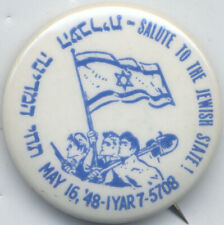
1948 Birth Jewish State of Israel Pin Pinback Button A Flag Is Born UNKNOWN $700.00
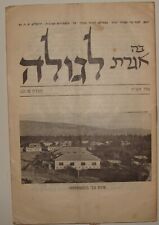
Jewish Judaica 1948 Palestine Israel Diaspora Zionist Bulletin Kibbutz Hebrew $35.00
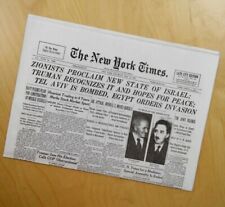
Israel Newspaper - New York Times of May 15, 1948 (Officially Licensed Reprint) $16.99
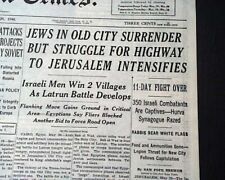
BATTLE FOR JERUSALEM Jews Jewish Mandatory Palestine Surrender 1948 Newspaper $48.00
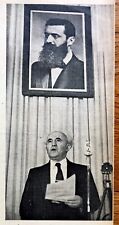
1948 Jewish ISRAEL STATE BIRTH Newspaper PHOTO MAGAZINE Hebrew INDEPENDENCE WAR $117.50
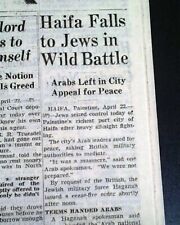
BATTLE OF HAIFA Operation Bi'ur Hametz Palestine Jews Jewish Arabs1948 Newspaper $48.00
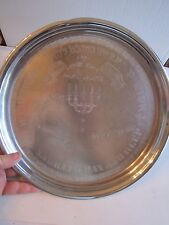
1948 JEWISH STATE OF ISRAEL PLATE - JUDAICA - SILVER PLATED - 12" DIAMETER - BMA $207.99
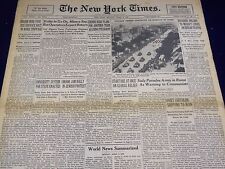
1948 APRIL 5 NEW YORK TIMES - JEWISH PROTEST RALLY - NT 2912 $45.00
|